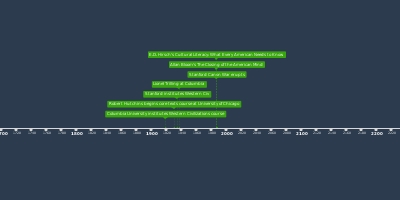20 gen 1919 anni - Frosh Contemporary Civ course introduced
Descrizione:
http://c250.columbia.edu/c250_celebrates/people_and_ideas/people_ideas_4.html"The course Contemporary Civilization is introduced for all freshmen; this marks the first step toward the creation of Columbia's core curriculum. It replaced the requirement in Philosophy A and History A.
"In his address at the University's opening exercises in September 1919, Nicholas Murray Butler, Columbia's president, noted that the University was going to be a dramatically different place than it had been a year earlier, when the country was still at war. But Butler could describe Columbia's new environment in only the most general terms: "We are here to gain a firmer message upon the realities of life, to get knowledge and to transmit it into wisdom, to find new understanding and to be guided to new interpretations, both of nature and life and of organized man."" (Timothy Cross, Oasis of Order https://www.college.columbia.edu/core/oasis/history1.php)4
from Cross: In this sense, from the start the program was interested in developing wise answers to contemporary problems as its central focus, not to impose a "core knowledge" on students. Cross also notes that though WWI was a contributing factor, prior changes at Columbia away from Greek and Latin entrance standards and towards disciplinary specialization and advanced studies were also influential. They dropped the Latin requirement in 1916. There was already disagreement about what the university was for, but these changes were moving towards the German model and professional ed. Grad school profs educated in Germany like John Burgess were openly hostile to humanities/liberal education espoused at Columbia College (undergrad). By contrast, John Howard Van Amringe thought of the college's purpose as "making men" and opposed its
merely becoming a "professional school". But to just be a finishing school for the wealthy??? Also problematic.
It was constructed consciously as a post WWI course, a "peace" course to meet needs of postwar realities and to help make the students "citizens who can participate in national affairs with clear judgment and intelligence." (Dean Herbert Hawkes, memo, qtd. in Cross, Oasis, 24)
This was not meant to be indoctrination. Cross: "The history professor Harry J. Carman (later dean of the College) complained of the American people that "the vast majority . . . never critically examine our existing social standards."25 In a private letter to his friend, the philosopher John Dewey, in 1920, Coss complained that America was "still temporizing with nearly every political and social issue, and facing squarely very few."26 Hawkes insisted that the course was "an attempt so to inform the students that their social usefulness will be increased in proportion as they follow the methods of intelligent investigation and discrimination."27 While it seems clear that the faculty believed that American culture could survive intense scrutiny, it is also clear that they thought such scrutiny was in order. CC would be the vehicle to bring political and social issues to students, just as they were beginning their college education......the goal was not only to provide a historical survey or even a history of ideas, but also "to throw into relief the chief characteristics of our age.""
Yet it was still quite comprehensive as an intellectual undertaking, with faculty writing books FOR THE COURSE.
The course faced challenges in staffing, as it had no dedicated faculty and needed to create a team. There was the problem of folks needing to teach outside their discipline, and it was often suggested to move to large lectures to mitigate the problem, but this would cost the seminar style. On the other side, though, see Cross: "For those who became involved in planning and teaching CC, however, the inevitable limitations of each instructor were not so much a problem to be overcome as an essential ingredient of the course. CC was designed, after all, as an introduction to, not the final statement on, its subject. It was expected that students would gain knowledge of several disciplines, thus helping their choice of a particular discipline later on. But that only intensified the obligations of teachers. Coss was well aware of the new burdens on the staff, remarking that the "teaching staff will be educating itself as well as instructing the students."39 This was not a bad thing for many. Carman noted that history teachers benefited from teaching CC. "Almost without exception," he insisted, "every member of the history staff who has taught the course enthusiastically declares that it has broadened his own intellectual outlook and enriched his history teaching."
"The University undertakes to restrict the admission of Jews and graduates of New York City public high schools into Columbia College, Barnard College, and the medical school, in an attempt to reserve places for its traditional Knickerbocker clientele. Restrictive policies remain in force through the 1930s. Still, the percentage of Jewish students attending Columbia is much higher than at other Ivy colleges, while Catholic students achieve a considerable numerical presence in the College."
Aggiunto al nastro di tempo:
Data:
20 gen 1919 anni
Adesso
~ 106 years ago
